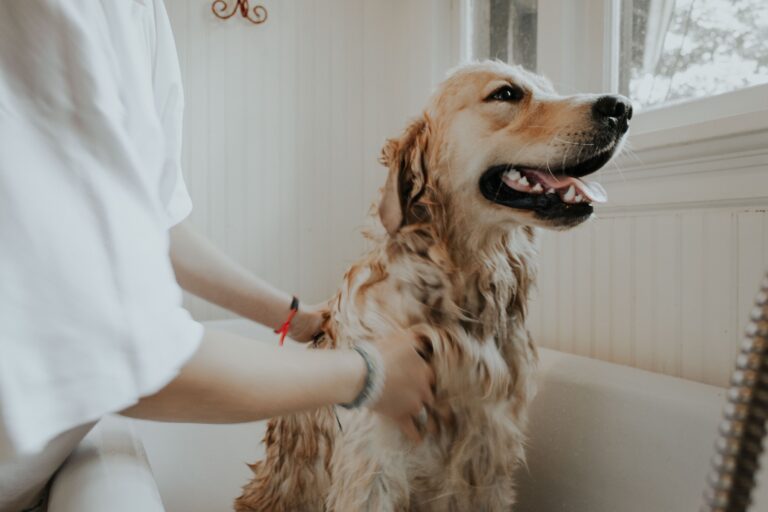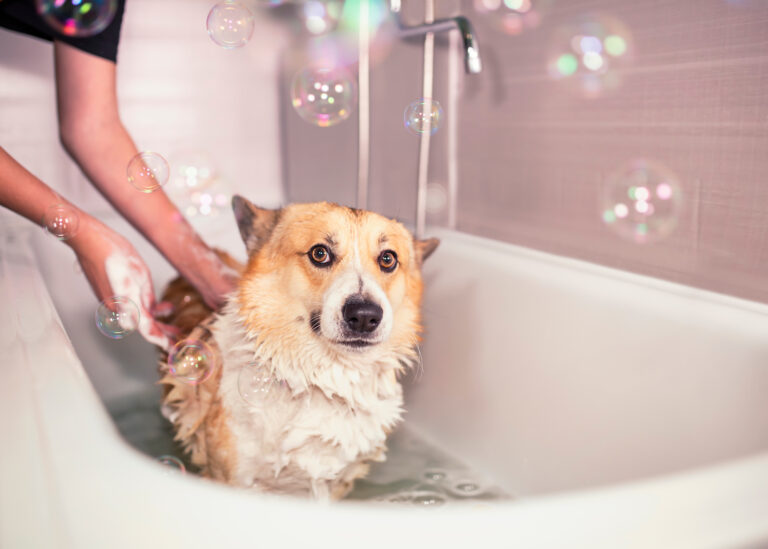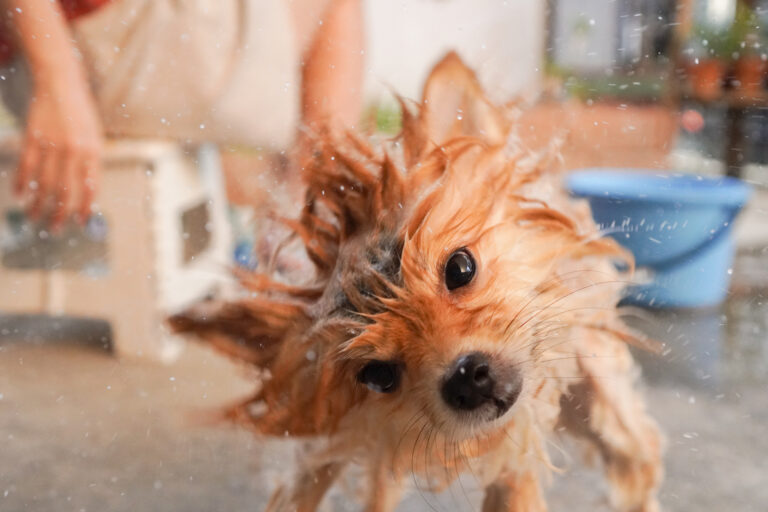Depending on your dog’s attitude toward the whole process, bath time can either be a fun, bonding time, or a deeply unpleasant chore. If it’s the latter, or if you’re just starting your bathing journey with your dog, there are steps you can take to help your dog view bathing as something to look forward to (or at least tolerate without a fuss). And if your dog already likes bath time, there are still some tips, tricks, and best practices to know to keep your dog’s coat healthy, and bath time fun.
Make your tub dog-friendly
Overall, the key to making bath time enjoyable for your pup is to go at your dog’s pace and help them develop positive associations with every aspect of being bathed.
One of the things that many dogs find upsetting about bathing is how slippery bathtubs (or sinks in the case of small dogs) are. Not only is slipping a scary experience, it can also be physically painful or uncomfortable. To help your dog feel more secure at bath time, put down an anti-slip rubber mat or even a towel or two in the bottom of the tub. If you’ve got some old towels around, consider putting them down all over the bathroom floor as well; this can prevent that slippery feeling and prevent water and hair from getting everywhere when the bath is done.
Make the bath a rewarding place
You can start to introduce your dog to the bathtub as soon as you bring a new dog home, or, if you already have a dog, start to make engaging with the tub a normal part of your everyday life. The key to making bath time less stressful for dogs is to help dogs to make positive associations by pairing the bath itself, and bath time, with things that your dog already likes, like toys and treats.
Practice the bathing steps
Practice getting in and out of the tub when it isn’t bath time. You can play games your dog likes near the tub, and engage with the tub as part of your daily routine. If your dog knows the “paws-up” trick of putting two paws up on an object, ask them to do that on the edge of the tub. If they don’t know paws-up you can take a treat, put it on your dog’s nose and lift the treat up until your dog’s front paws are up on the edge of the tub then praise and give them a treat.
The next step is to get your dog into the tub. For safety’s sake, it’s a good idea to lift your dog in, if you can. If you have a low tub, a big enough dog, and you have a non-slip mat down, you can see if your dog will willingly jump in to the tub. When your dog is in the tub, give healthy treats and lots of praise—then immediately take them out of the tub. Repeat this regularly. By spending a bit of time making the tub a highly rewarding place, you can increase your dog’s comfort-level with bath time.
Tub not an option? If you’ve got a big dog, or if the thought of getting your dog in and out of the tub is… too much… look for a DIY facility near you that has elevated tubs. You can also find portable plastic or collapsible pet grooming tubs that you can use outside or elsewhere in your house. Just be sure to mind the water temperature (freezing water out of the hose could be counterproductive and reinforce negative feelings about baths). You can also outsource the whole operation to a trusted groomer.
Tub tricks
When your dog is in the tub, pet them all over their back, legs, chest, tail and head. Go slow and offer lots of praise and small bits of treats. The idea is to get your dog comfortable with being handled in the tub before you add water and shampoo. Keep sessions in the tub short and positive.
Give them something to focus on while in the tub. In addition to offering treats, you can try a technique that many dog owners have found works wonders: spread a small amount of peanut butter on the wall of the shower or tub and give your dog the chance to lick it off while standing in the tub. This creates a fun tub-time activity, and a rewarding distraction (be sure your shower/tub is clean, and that all cleaning products are thoroughly rinsed off). If you’re not crazy about the idea of putting food on your shower wall, you can buy a small rubber dispenser for this purpose that sticks on the wall with a suction cup.
Introduce the water
When your dog is comfortable getting into and out of the tub, and is happy to stand in the empty tub, it’s time to start introducing water. Turn on the water a little bit and praise and offer a treat. Offer some treats (or use the peanut butter on the wall trick) while leaving the water running. Turn the water off, praise your dog and take them out of the tub. Repeat over a few sessions if necessary so your dog becomes comfortable with the water running and their feet getting wet.
A note on water temperature: Your dog’s skin is sensitive; make sure you bathe your dog in lukewarm, not hot, water. The water should feel a bit cooler than you would normally use for a bath.
Start bathing
Once your dog is comfortable spending time in the tub with the water on and filled to at or just below their belly, you’re ready to start actually bathing them.
Brush them out first
It’s a good idea to brush out your dog’s coat before they take a bath (especially if they have a thick coat) to get any mats and tangles out.
Use dog shampoo
No matter how “natural” your own shampoo is, make sure to always use shampoo that is made specifically for dogs. The skin of a dog is different from our skin—it’s thinner on average, more sensitive, and has a different pH. Using a shampoo designed for humans on a dog disrupts the chemistry of their skin and can leave them vulnerable to bacteria, fungi and parasites, as well as contributing to dry, flaky skin.
Dogs with skin conditions and allergies may need medicated shampoos and a special, more frequent bath schedule. If you notice your dog has any skin irritation, or has a history of allergies or other skin conditions, talk with your veterinarian to discuss how frequently your dog should be bathed and what shampoo/conditioner is best for you to use.
Watch the ears
One area you don’t want to wash is inside the ears—in fact, you want to keep the bathwater well away from their ears. Many veterinarians recommend placing cotton balls in your dog’s ears, if they’ll allow it, to prevent water from getting in, which can contribute to secondary ear infections. Just remember to take them out after! You can also clean your dog’s ears after the bath with a general, vet-approved cleaning/drying solution.
Shampoo carefully, and rinse well
Once your dog is situated in the tub and treats are at the ready, start washing all the parts from the neck down. Instead of lathering the face, which your dog may find unpleasant and risks soap irritating the eyes, use a washcloth to clean this area.
Wet each area thoroughly with warm water and then apply shampoo, wash, and rinse. Again, your dog’s skin is sensitive, so be sure to rinse really well. A detachable shower head is a big plus here, if it’s an option for you to install one. If you don’t have an attachment, it’s handy to have a container on hand to use for rinsing. Continue to praise your dog, providing treats and/or adding more peanut butter to keep your dog busy.
Use bath toys!
Bath toys aren’t just for human kids; pups love toys in the bath as well! Floating water toys and balls can be fun for dogs to engage with. For some dogs, the addition of toys in the tub can help bath time to feel more like a game than a chore. Some dogs, especially retrievers, enjoy just carrying a favorite waterproof toy while in the tub.
How often to bathe your dog
How often you bathe your dog can come down to breed, lifestyle, the season, and other factors. Generally, you should aim for no more than once a month, and many dogs don’t need to be bathed that frequently.
Of course, if your dog is a regular swimmer and/or spends a lot of time rolling in dirt and poop, you’ll have to adapt your bathing schedule. Surprisingly, hairless breeds of dogs may need more regular baths than dogs with fur in order to keep their skin from getting irritated.
Post-bath
When your dog gets out of the bath, try to keep them contained in the bathroom and dry them from head to paw with a towel (or towels). Let them shake (nothing you can or should do to stop this!) There are differing opinions on using hair dryers, but overall it’s better to avoid using them if possible, as they can dry out the skin and coat. If you do use a dryer, it’s important to keep it on a cooler setting to avoid burns and dryness (you can buy dog-specific dryers that are quieter and allow more heat control).
And, if you’ve ever bathed a dog before, you know what’s coming next… After a bath, many dogs will engage in zoomies, and/or immediately dive onto the nearest carpet, lawn, or other surface. Keep this in mind when you let your dog out of the bathroom—don’t immediately let them outside while they’re wet or you’re liable to undo all the cleaning you just did. End your bath session by brushing your dog and giving them one last healthy treat for being the sweetest (and sweetest-smelling) pup on the block.












